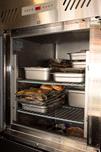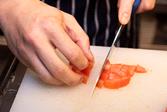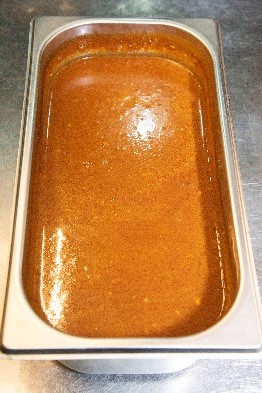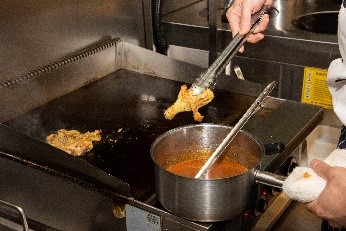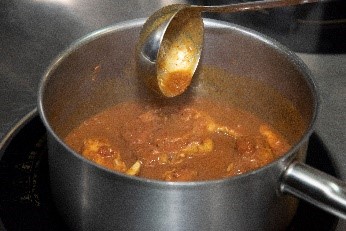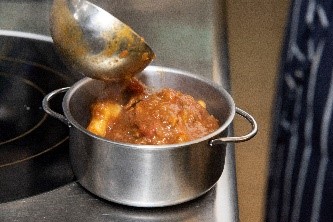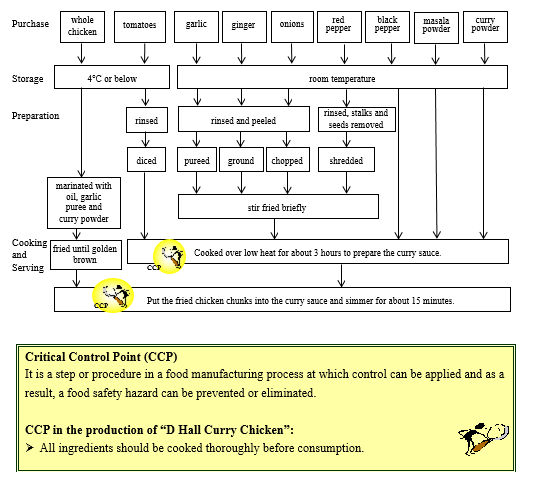
Feature Article
Tips for Using Deep-frying Oil
Deep-frying is a common cooking method for crispy and delicious foods such as chips, French toast, doughnuts, spring rolls and tempura, but do you know that there are many points to note when using deep-frying oil?
During the deep-frying process, oil is exposed to high temperatures in the presence of oxygen in air and moisture in food. A series of chemical reactions occur. Most chemical compounds resulted from these reactions are relatively polar (i.e. unequal distribution of electrons) in nature. They can accelerate oil deterioration and may affect the oil quality and food safety.
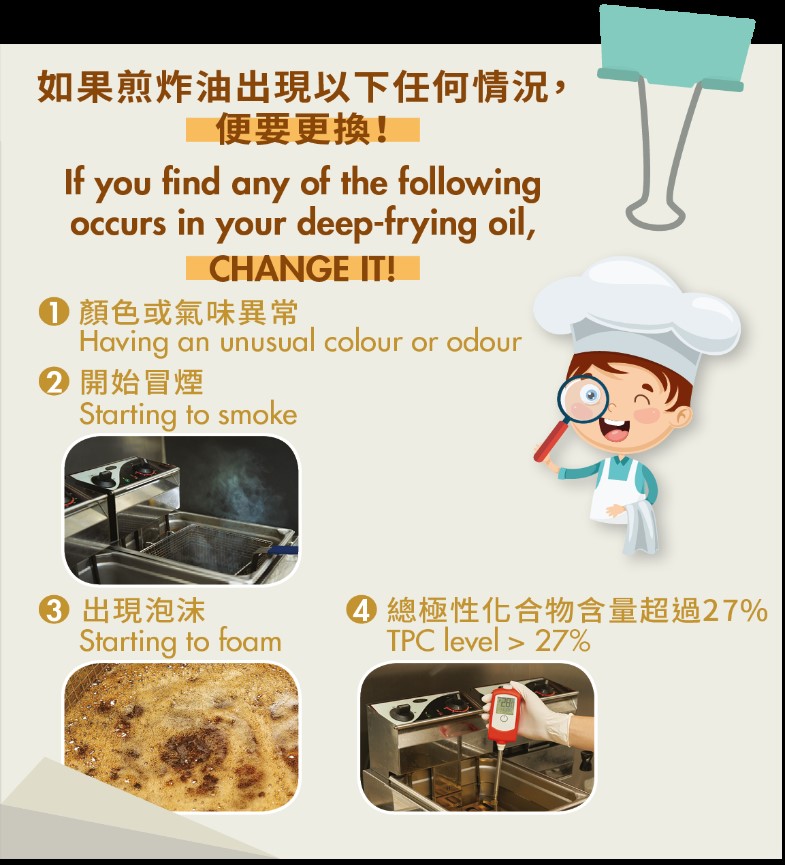
Indicators for changing deep-frying oil
Recommendations on Use of Deep-frying Oil
To assist the trade in ensuring food safety and enhancing food quality throughout the deep-frying process, the Centre for Food Safety (CFS) has commissioned a local university to conduct a study and devise the Trade Guidelines on the Use of Deep-frying Oil (the Guidelines). Developed in consultation with the trade and published in October 2019, the Guidelines are available for viewing on the CFS website.
Among other things, the Guidelines recommend the following on the use of deep-frying oil. The public can make reference to these useful tips when deep frying food as appropriate.
Before Deep-frying
There is a wide selection of cooking oils. It is important to choose the suitable ones for deep-frying. Cooking oils with a higher level of monounsaturated fatty acids, like rapeseed oil (including canola oil) and high-oleic sunflower oil, are relatively stable at high temperatures and good for cardiac health, making them a more suitable option for deep-frying.
Moisture in food and residues of fry coating mix and batter can result in deterioration of oil. Therefore, moisture, fry coating mix and batter on the food surface should be minimised before deep-frying.
During Deep-frying
While deep-frying at an excessively high temperature accelerates oil deterioration, oil absorption into food will increase if too low a temperature is used. It is important that the oil temperature is controlled within the range of 150°C and 180°C during deep-frying.
After Deep-frying
Small residues in the oil such as food particles and bread crumbs can char easily and speed up oil degradation. They should be removed from the fryer frequently. Besides, salt promotes the migration of water from inside the food to its surface, leading to hydrolysis of the oil. Therefore, food should be seasoned after deep-frying as far as possible.
When the fryer is idle, such as during shift breaks, lower the oil temperature setting to 120°C to 130°C to avoid prolonged heating or frequent heating up and cooling down of the oil. When the fryer is turned off, such as after business hours, cover it to minimise exposure to light and air in order to slow down photo-oxidation and oxidation in the oil. Regular cleaning of the fryer also helps avoid accumulation of food residues.
When Should We Change Oil?
The oil deterioration rate can be affected by various factors, such as the type and the amount of food deep fried in the oil and the frying temperature. It is difficult to recommend the frequency of changing the deep-frying oil solely based on a fixed time period or the number of times it has been used.
The deep-frying oil should be changed if it has an unusual colour or odour (e.g. a rancid smell) or starts to smoke (i.e. smoking occurs at the recommended frying temperatures (150°C to 180°C)) or foam (i.e. formation of a milky foam that cannot dissipate easily). For a more objective assessment, the CFS suggests that traders consider measuring the total polar compounds (TPC) in the deep-frying oil, a comparatively reliable benchmark to determine the extent of oil degradation. The oil should be discarded when the TPC value is greater than 27%. Last but not least, it is not advisable to put in fresh oil for oil dilution or as a means to prolong oil use.
Readers' Corner
Food Poisoning Caused by Salmonella in Soft Scrambled Eggs
With a smooth and creamy texture, omurice (Japanese fried-rice omelette), soft-scrambled egg omelette and soft boiled eggs are popular among customers. However, there are safety risks consuming dishes prepared with undercooked eggs. In May and June 2019, two food poisoning outbreaks related to the consumption of soft scrambled eggs were reported in Hong Kong, involving 7 and 40 victims respectively. The victims suffered from abdominal pain, vomiting, diarrhoea and fever. Some required hospitalisation. These two cases were associated with inadequate cooking of soft scrambled eggs and/or improper holding temperature of the eggs after cooking, the causative agent being Salmonella.
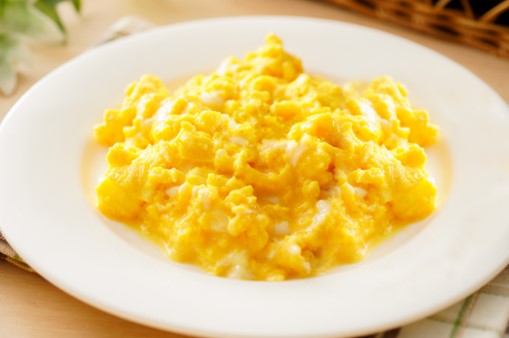
Undercooked egg dishes such as soft scrambled eggs have an inherent risk of food poisoning caused by Salmonella.
What is the Source of Salmonella? The Hen or the Egg?
Salmonella first infects hens and then their eggs. During or after egg laying, eggs can become contaminated with Salmonella through the eggshell as a result of contaminated faeces. Salmonella can also contaminate eggs through infection of reproductive organs of hens before the shell is formed. It is not possible to distinguish with the naked eye whether an egg is contaminated with Salmonella.
Risks of Consuming Undercooked Eggs
Salmonella can survive in undercooked eggs. Even when there is no cross contamination in the process of making egg dishes, Salmonella in eggs can still cause food poisoning. Improper storage temperature (e.g. room temperature at 25°C) will also facilitate Salmonella in undercooked eggs to multiply rapidly. The incubation period for Salmonella ranges from 6 to 72 hours, usually 12 to 36 hours. The symptoms include abdominal pain, vomiting, diarrhoea and fever. In severe cases, which are less common, complications such as septicaemia, dehydration and even death may occur.
Implementing Five Keys to Food Safety to Reduce Food Poisoning
As food poisoning caused by Salmonella in egg dishes is related to improper cooking and holding temperature, special attention should be paid to whether the food is fully cooked and kept at proper temperatures. Foodborne diseases can be prevented by practising the Five Keys to Food Safety, namely (1) to choose wisely; (2) to keep clean; (3) to separate raw and cooked food; (4) to cook thoroughly; and (5) to keep food at safe temperatures.
Thorough cooking and heating can destroy bacteria in food, including Salmonella. Food should be cooked to a core temperature of at least 75°C. Cooked foods that are served hot should be kept above 60°C prior to serving, while cold dishes should be stored at 4°C or below. Moreover, cooked foods should be consumed immediately and not left at room temperature for more than 2 hours. Cooked foods kept at room temperature for more than 4 hours should be discarded.
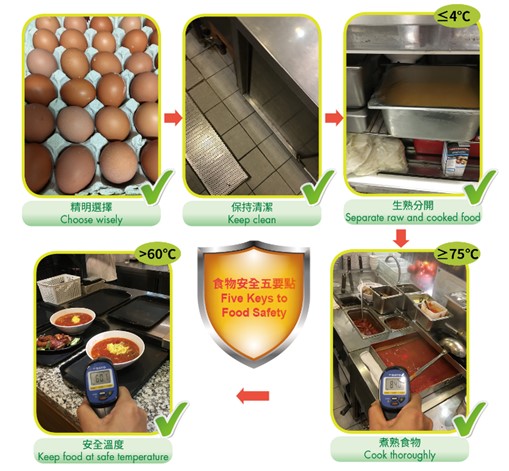
Examples of preparing egg dishes by following the Five Keys to Food Safety
Key Points to Note
- Salmonella can contaminate eggs during egg formation. It is not possible to distinguish contaminated eggs from the normal ones with the naked eye.
- Salmonella can survive in undercooked food. It is risky to consume egg dishes prepared with raw or undercooked eggs.
- By following the Five Keys to Food Safety, the risk of foodborne illnesses can be minimised.
Advice to Consumers
- There is an inherent risk of Salmonella contamination in undercooked egg dishes.
- Choose dishes prepared with pasteurised eggs, egg products or egg powder.
- High-risk groups including pregnant women, young children, the elderly and immunocompromised persons are advised not to consume raw or undercooked egg dishes.
- When eating out, check with the restaurant whether the chosen dishes are made with undercooked eggs. Ask the restaurant to cook the eggs thoroughly when necessary.
News on New Dishes
D Hall Chicken Curry
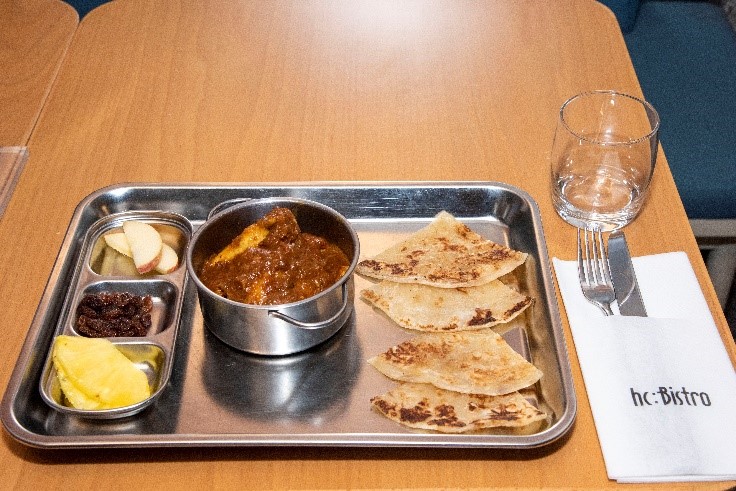
Rich in aroma and taste, curries are all-time favourite foods for many people. In this issue, Mr CHEUNG, master chef of "hc:Bistro", will show us how to prepare the curry dish "D Hall Chicken Curry", so named as the social enterprise restaurant is situated at the former D Hall of Victoria Prison (now revitalised as Tai Kwun) in Central. It is a characteristic dish inspired by the curry meals provided for inmates of the prison in the past. Let's learn how to make it.
| Preparation Steps | Small Tips, Big Wisdom | |
|---|---|---|
|
Receiving |
Purchase a whole chicken, curry powder, masala powder, black pepper, tomatoes, onions, ginger, garlic and red peppers from approved and reliable suppliers. |
Upon receipt of the ingredients, check carefully to ensure their freshness. Place curry powder, masala powder, black pepper, onions, ginger, garlic and red peppers on dry goods shelves. The chicken and the tomatoes should be refrigerated at 4°C or below. Order the right amount of ingredients to ensure their freshness. |
|
Rinsing & Cutting |
Rinse tomatoes, garlic, ginger, onions and red peppers thoroughly under running water. Dice tomatoes and shred red peppers after removing stalks and seeds. Peel garlic, ginger and onions. Puree garlic and grind ginger into paste. Chop onions into small pieces. Set aside. |
Rinsing the ingredients thoroughly under clean running water can effectively remove unwanted substances and reduce the risk of pesticide intake. |
|
Marinating |
Take the chicken out of the refrigerator. Rinse it and cut into chunks. Marinate the chicken with curry powder, garlic puree and some oil. |
Marinating the chicken with some oil can reduce moisture loss and preserve the flavour of chicken meat. For better absorption of flavours, marinate the chicken one day in advance and keep them refrigerated at 4°C or below for later use. |
|
Cooking (1) |
Heat the wok and add some oil. Stir fry garlic puree, ginger paste, onions and red peppers until fragrant. Add curry powder, masala powder, tomatoes, black pepper and water into the wok. Cook over low heat for about 3 hours to prepare the curry sauce. |
Keep the curry sauce warm at 60°C or above after preparation. If the sauce is not used immediately, it should be cooled quickly and refrigerated at 4°C or below. |
|
Cooking (2) |
Preheat the griddle and add some oil. Fry the marinated chicken until golden brown. Add a pinch of salt and pepper for seasoning. Put the fried chicken into the curry sauce and simmer for about 15 minutes. |
As the chicken contain fats, only a small amount of oil is needed for frying them. Frying the chicken briefly until golden brown will make them crunchy on the outside and look more appealing. Seasoning with a pinch of salt and pepper can enhance the taste of the chicken. |
|
Serving |
Put the well-cooked chicken chunks into a container. Pour the curry sauce over them. Served with Indian flatbread and other side dishes. |
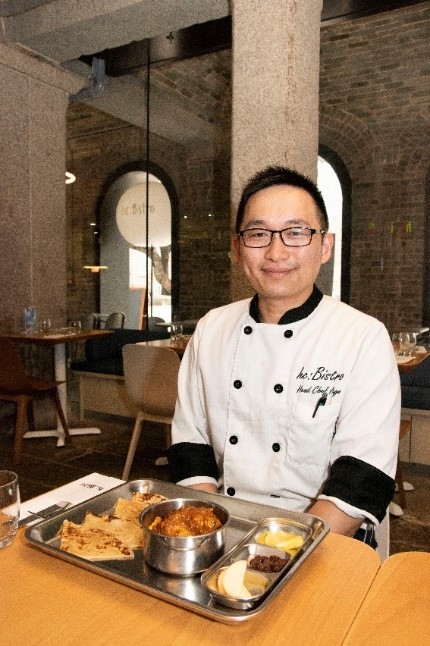
Tips from the Chef:
- Frying the chicken chunks briefly until golden brown and simmering them over low heat will keep the meat moist and tender.
- Add pineapple and raisins as side dishes. Their sweet and sour tastes can neutralise the spiciness of curry.
Food Safety Plan Corner
D Hall Chicken Curry
Ingredients:
A whole chicken, tomatoes, garlic, ginger, onions, red peppers, black pepper, curry powder and masala powder
Steps:
- Take out garlic, ginger, onions and red peppers from the dry goods shelves and rinse them thoroughly under clean running water. Peel garlic, ginger and onions. Puree garlic and grind ginger into paste. Chop onions into small pieces. Shred red peppers after removing stalks and seeds. Set aside.
- Take out tomatoes that are refrigerated at 4°C or below. Rinse them thoroughly under clean running water. Dice them after removing stalks and seeds. Set aside.
- Heat the wok and add some oil. Stir fry garlic puree, ginger paste, onions and red pepper until fragrant. Add curry powder, masala powder, tomatoes, black pepper and water into the wok and cook over low heat for about 3 hours to prepare the curry sauce.
- Take out the chicken that is refrigerated at 4°C or below. Rinse the chicken and cut it into chunks. Marinate the chicken with garlic puree, curry powder and oil.
- Preheat the griddle and add some oil. Fry the marinated chicken until golden brown. Add a pinch of salt and pepper for seasoning.
- Put the fried chicken chunks into the curry sauce and simmer for about 15 minutes.
Production Process
Briefing of Activities
1) Relocation of Communication Resource Unit
The Communication Resource Unit (CRU) of the CFS was relocated from 8/F, Fa Yuen Street Municipal Services Building, 123A Fa Yuen Street, Mong Kok, Kowloon to Room 401, 4/F, Food and Environmental Hygiene Department Nam Cheong Offices and Vehicle Depot, 87 Yen Chow Street West, Sham Shui Po, Kowloon on 22 July 2019.
The CRU maintains a rich collection of food safety resource materials which help consumers make informed food choices and the trade supply safe food. The new CRU office has set up an exhibition hall with information corners and audiovisual facilities for visitors to gain direct access to food safety information in Hong Kong. For enquiries, please contact the CRU at 2381 6096 during office hours.
Exit C of Nam Cheong MTR Station
Food and Environmental Hygiene Department Nam Cheong Offices and Vehicle Depot
2) Enhanced Regulation to Protect the Public from Metallic Contaminants in Food
The Food Adulteration (Metallic Contamination) (Amendment) Regulation 2018 (the Regulation) came into force on 1 November 2019. It is first applicable to certain fresh foods with a shorter shelf life such as fruits, vegetables, aquatic animals, poultry and meat. Commencing on 1 November 2020, the Regulation will also cover other foods which normally have a longer shelf/storage life.
Excessive dietary exposure to metallic contaminants may lead to various adverse health effects. The enhanced Regulation covers more metallic contaminants and food items to align local standards with the Codex standards as far as possible. Some local standards (e.g. methylmercury in fish) are even more stringent than the Codex ones. These standards have been set to achieve better health protection for the local population by taking into account the local consumption amount of the particular food and the associated risks.
While the Regulation is enhanced, the public should note that low levels of metallic contaminants in foods are unavoidable as they are present everywhere in the modern industrial world. The public is advised to maintain a balanced diet to avoid excessive exposure to metallic contaminants from a small range of food items.
3) CFS Instagram (IG) Page Goes Online
The CFS has been disseminating food safety messages to the general public through social media. In addition to Facebook, the CFS has launched a new IG page to share food safety information with the public, including clarifying food misconceptions. You are welcome to visit our IG page (www.instagram.com/cfs.hk) to learn more.
Follow us on @cfs.hk
CFS Instagram page
Upcoming Activities
Roving Exhibitions on Food Safety
The CFS organises thematic exhibitions in shopping centres of public housing estates, Home Ownership Scheme estates and private housing estates, as well as government offices and markets managed by the Food and Environmental Hygiene Department (FEHD) across the territory. There are exhibition boards on various food safety and nutrition topics, including the Five Keys to Food Safety, Nutrition Labelling, Trans Fat, Organic Food, Genetically Modified Food and Natural Toxins in Food. The staff on site will show educational videos and distribute leaflets and souvenirs to visitors during the exhibitions.
The venue and time of the roving exhibitions will be published on the CFS website (https://www.cfs.gov.hk/tc_chi/whatsnew/whatsnew_act/whatsnew_act.html). Members of the public are welcome to visit these exhibitions.
Food Safety Q&A
Will We Contract AIDS by Consuming Canned Fruits?
Siu Ming is having a fever. His mother takes him to a doctor.
Doctor: Good morning, kid. What's wrong with you?
Mom: Good morning, doctor. My son had a slight fever the night before last. I took his temperature this morning and it went up to 39ºC. He's also experiencing diarrhea.
Siu Ming: Doctor, I'm about to die. I may have AIDS! My classmate and I ate some canned pineapples at school the day before yesterday. Both of us developed a fever that night. We have become tired and weak. We also have sore throats and can’t eat a thing. I learnt from the Internet that HIV is present in canned pineapples. That freaks me out!
Doctor: HIV stands for Human Immunodeficiency Virus. It is the cause of AIDS. According to the World Health Organization, HIV can't be transmitted by water or food. In fact, HIV doesn't live long outside the human body. Even if the food contains small amounts of HIV-infected blood or semen, exposure to the air, heat from cooking and stomach acid would destroy the virus. Based on the current scientific evidence, the World Health Organization and the US Centers for Disease Control and Prevention do not consider that food is a source of HIV infection. There should be no worries about contracting AIDS because of eating canned fruits contaminated with HIV. Your concerns are unfounded.
Let me examine you first. Well, your throat is a bit red and swollen, it's a sign of mild inflammation. It's likely that you are infected by your classmate. I'll prescribe some medicine to you. Come back two days later for follow-up consultation, and we'll see if you're getting better. Don't worry.
Mom: Thank you, doctor. I'm relieved that my son is alright.
Truth Against Fallacy
Is Smoked Salmon Safer for Consumption Than Sashimi?
According to the Food Business Regulation under the Public Health and Municipal Services Ordinance (Cap. 132), sushi and sashimi are classified as restricted food. Sashimi is food consisting of fillets of marine fish, molluscs, crustaceans, fish roe or other seafood to be eaten in its raw state. It is a high-risk food that can lead to food poisoning and even parasitic infection if prepared improperly.
Does it mean that salted and smoked salmon is safer for consumption than sashimi?
Smoked salmon in the market is usually prepared by hot smoking or cold smoking. In hot smoking, salmon is smoked at around 70°C to 80°C with the flesh thoroughly cooked. As for cold smoking, the fish is smoked at a temperature not higher than 33°C. It is not fully cooked and the protein in the flesh will not coagulate. Unlike hot smoking, the cooking temperature of cold smoking is generally insufficient to eliminate pathogens like Listeria monocytogenes (L. monocytogenes).
L. monocytogenes is ubiquitous in the environment. It can grow slowly at refrigeration temperatures. Salmon, raw or cold-smoked, may contain a small amount of L. monocytogenes. Various food recalls due to L. monocytogenes contamination in cold-smoked salmon have been reported all over the world. There is also indirect epidemiological evidence associating contaminated smoked fish with human listeriosis cases.
Generally speaking, foods containing low levels of L. monocytogenes (e.g. <100 colony-forming units (cfu)/g) pose very little risk to consumers. However, as the number of bacteria increases, consumers will be at risk of listeriosis. While most healthy individuals do not develop symptoms or only have mild symptoms when infected, severe complications such as septicaemia, meningitis or even death may occur in the susceptible population, including the elderly, young children and people with weakened immunity. Listeriosis during pregnancy can lead to miscarriage, stillbirth, premature delivery or infection in newborns. Hence, effective control measures to prevent L. monocytogenes contamination and inhibit its growth are of prime importance in ensuring food safety in the production of cold-smoked salmon.
In summary, sashimi and cold-smoked salmon are high-risk foods. Members of the public are advised to purchase them from reliable and reputable sources.
Advice to the Public
- The susceptible population should avoid consuming sashimi or ready-to-eat foods with long shelf lives under refrigeration (e.g. cold-smoked salmon, soft cheeses and deli meat).
- Store smoked salmon strictly in accordance with the instructions on the label.
- Avoid consuming smoked salmon beyond its "use by" date.
- Shops/Restaurants are required to obtain a relevant permit from the FEHD for sale of sashimi for human consumption. Members of the public are advised to buy sashimi from food outlets issued with such permits.
- Some fish species (e.g. tuna, alfonsino, swordfish and marlin) used for preparing sashimi may contain relatively high level of mercury. Members of the public should consume different types of fish to reduce the risk of mercury intake.
Brain Gym
Fill in the blanks
- The cooking temperature of a is generally insufficient in eliminating Listeria monocytogenes in smoked salmon.
- People with weakened immunity such as the elderly, pregnant women or b should avoid eating fish/seafood that are raw or not fully cooked.
- The Code of Practice for Fish and Fishery Products issued by the Codex Alimentarius Commission states that freezing fish at -20ºC or below for 7 days or at -35ºC for about 20 hours can kill c and effectively minimise the risk of parasitic infection.
Answers:
a = cold-smoking b = young children c = parasites
Enquiries and Subscription
Printed copies of the Food Safety Bulletin can be obtained from the CRU at Room 401, 4/F, Food and Environmental Hygiene Department Nam Cheong Offices and Vehicle Depot, 87 Yen Chow Street West, Sham Shui Po, Kowloon. For enquiries, please call 2381 6096. The public may also visit the CFS website (www.cfs.gov.hk) for the online version.
